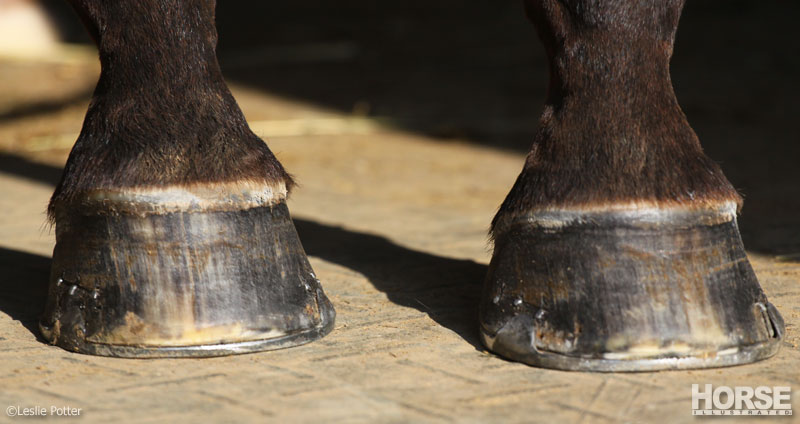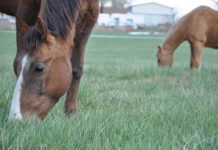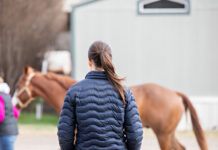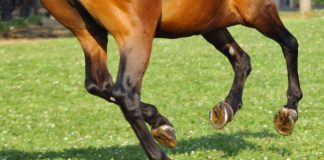Devoted equestrians spend hard-earned money to maintain their horses’ good physical condition. Regular veterinarian visits and a call from the farrier every six to eight weeks just scratch the surface of annual expenses.

A farrier’s skill and level of expertise can impact whether a horse is sound for performance duties in the show arena or on the trail. But how many equestrians know if their companions are receiving a quality shoeing from their farrier? To rate a shoeing keep the following in mind the next time you pick up your horse’s hooves.
Southern California farrier Jesse Coker suggested the following evidence can help determine a good shoeing over a poor one.
Good Shoeing Components
1. The foot should look clean and tidy. “There shouldn’t be any large cracks or splits. The hoof should not have any gouges from a farrier’s rasping of the foot.”
2. The front feet and back feet should be the same length from the coronet band to the shoe. “The heels should be close to the same length, but keep in mind some horses have uneven heels so the farrier can only get so close.”
3. Right after your horse is shod, observe him traveling at a walk. “The front feet should land flat on the ground. They should not hit first on one side before the other, outside or inside.
4. Observe for correct size of shoes. “The shoe should fit the horse’s heels by allowing enough expansion room, about 1/8 of an inch on the outside.” The front angle of the hoof should line up with the pastern, so the horse doesn’t “knuckle over” or “break back” in its pastern.
5. Inspect the nails for location. “The nails should be driven high enough so the hoof doesn’t split. A nail can’t be too high, but it can be too deep which can result in an extremely sore horse.”
Poor Quality Shoeing
Watch for these trouble signs:
1. Your equine companion is sore after a recent shoeing. Call the farrier first. “It might be something easy to resolve, even farriers are human and can make mistakes. Good farriers can almost always fix their own mistakes.” If the horse continues to be lame, contact your veterinarian.
2. A poor shoe fit. Jesse reminds owners, “If a shoe fits too closely in the heels, it can cause corns and sore contracted heels.” If a the shoe is an improper size, too small for the foot, the animal could receive a “hot nail,” one that ends up positioned in the bottom of the hoof, that could cause soreness or splitting of the wall.
3. A previously sure-footed horse that begins to trip regularly after a farrier visit. “Tripping generally means the toes are too long or the heels are sore.” In most situations, the shoes should be placed about 1 1/4 inches in front of the frog. “If the shoe is correctly placed on the toe, and they aren’t too tight on the heels, the horse might need something like bar shoes to give more support to the leg and heels.”
4. Your horse loses shoes on a frequent basis. “This sometimes can’t be avoided, but if the front shoes stick out behind the heels too far, the horse will be apt to pull them off.” Sometimes, if the front feet are too long in the toe, the animal can’t get his feet out the way quickly enough to avoid pulling one off. “Some horses just have poor conformation and are prone to pulling off shoes.”
“Properly trimmed hoofs, not too long or too short, with a shoe fitted properly to the conformation of the horse and hoof will make nailing of the shoe on the foot much easier,” said Melvin Reynolds, a farrier for 30 years located in Orange County, serves hunter, jumper, dressage and western reining clients. Hooves that are too long develop flares and cracking which result in driving the nails too low, with no integrity to the nailing. A foot trimmed too short will make nailing difficult because the sensitive parts of the hoof are more easily penetrated by a poorly driven nail.
“Poor shoeing is the result of lack of understanding of the characteristics of the hoof and how a horse moves as it performs,” Reynolds explained. Excessive knifing of the sole and frog leave feet too short. Conversely, leaving too much dead sole and frog results in hoofs being too long and excessive backing up of the toe to establish a better angle.
“Shoes that are too small or too big are often the result of not knowing where the sensitive structures of the foot are located within the hoof,” Reynolds said. “A bigger hoof is not necessarily a better hoof, but a hoof trimmed and shod with a proper sized shoe will be.”
Shoes larger than appropriate will damage a hoof as much as those that are too small. A shoe fit to support and enhance a horse’s unique self is the goal of every quality shoe job.
The next time you clean out your horse’s feet before a ride, take a few moments and check your horse’s feet for proper foot shoe size, trimming, nail placement, flaring, cracks or splits in the walls of the hoofs. Then saddle up and monitor him for soundness and way of going.
Any questions or concerns you have about your horse’s shoeing should be discussed with your farrier. A professional farrier will listen and make an honest attempt to resolve any shoeing issue. Most problems can be solved by not allowing small situations to become large.
Further Reading
8 Hoof Care Myths
The Right Shoer
Barbara J. Janesick, a lifetime Arabian horse owner for more than 40 years, owns an energetic 29-year-old Arabian gelding, who still performs pleasure trail duty.







Not bad – i’ve been shoeing horses for 18 years in the San Francisco area. fortunately i’ve never had a horse come up lame from my method of shoeing which by the way was not taught me in horseshoeing schools or textbooks. Most of what you’re saying is right on there were a couple things i could improve on. You might want to check out my blog at http://Farrieritis.Care4Horses.com
thanks for the article
john silveira
yup it sounds like my farrier does a pretty good job.
Kudos to my farrier Luke at the Dell in Murillo, Ontario, Canada.
I come from a family of farriers. Collectively there are 80 years of horseshoeing expierence between all of us. This article contains a lot of good information, but there are a few misconceptions that I would like to clear up. First, picture of two front feet at the top of the article: these feet appear to be flared and have excessive length. Second, if a horse has a crack in it’s hoof it does not necessarily mean that the farrier is at fault. For instance, a horse could have done damage to the coronet band. When this occurs the injury to the coronet band reflects in the hoof wall. It is not uncommon for a horse owner, or even a farrier, to interpret this as a crack even though it is purely superficial. Finally, making the hind feet measure the same length as the front results in leaving excessive toe on the hind feet. This is so because a horse bares the majority of it’s weight in front resulting in front feet being larger in size. Similarly, if a person is right handed their left hand will be slightly smaller because it is not being used as much. This article contains lots of great information, but there are a few things that I simply could not let go without a response.
the picture seems to show a bad job with those clips…. not burned in, nor cut in. Just pounded over into the wall? That’s another sign…….